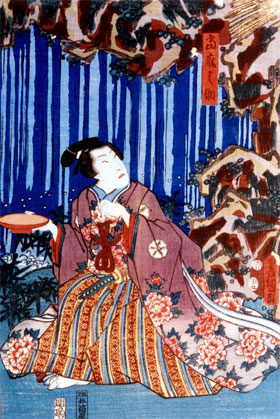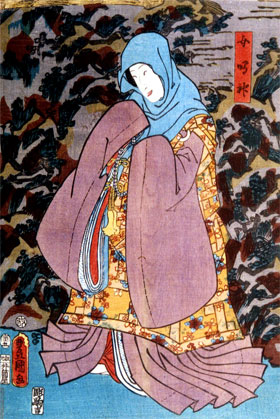| ONNA NARUKAMI |
| Play title | Neko no Koneko Kumo no Uwasa Onna Narukami Z˘ho Onna Narukami |
||||||||||||||||||||||||||||||||||||
| Authors | Shinoda Sasuke ("Kumo no Uwasa Onna Narukami") Fukuchi ďchi, Kawatake Shinshichi III ("Z˘ho Onna Narukami") |
||||||||||||||||||||||||||||||||||||
| History |
The first kakikae ky˘gen based on "Narukami", with a female Narukami instead of a male Narukami, was entitled "Neko no Koneko" and was premiered in the 11th lunar month of 1696 at the Nakamuraza; the role of the nun Narukami was played by the Kamigata star Ogino Sawanoj˘ [more details]. Another important version of "Onna Narukami" was Shinoda Sasuke's drama "Kumo no Uwasa Onna Narukami", which was premiered in the 6th lunar month of 1854 at the Kawarasakiza [casting]. The current version of "Onna Narukami" is based on the script written by Kawatake Shinshichi III and modified by Fukuchi ďchi. This drama was entitled "Z˘ho Onna Narukami" and premiered in September 1891 at the Kabukiza [more details]. It mixed Gidayű, Nagauta and Tokiwazu musical ensembles. "Onna Narukami", which used to be a popular drama in koshibai, is rarely-staged on Kabuki stages nowadays. We've found only 8 records of performances in ˘shibai between 1948 and 2016:
|
||||||||||||||||||||||||||||||||||||
| Structure |
"Onna Narukami" is made up of one act. |
||||||||||||||||||||||||||||||||||||
| Key words |
Ama Jidaimono Kakikae Ky˘gen Narukami Oda Nobunaga Oshimodoshi Tokiwazu |
||||||||||||||||||||||||||||||||||||
| Summary |
Not a drop of rain has fallen since the ama Narukami has cast a spell. She has prevented rain from falling on the earth by holding hostage the dragon god, who produces the rain. The god has been locked up into a pool of water beneath a waterfall near Narukami's hermitage. The land has been without rain for over a hundred days. Narukami's acolytes [1] enter. They share a laugh over the fact that their priestess has everyone fooled into thinking she is actually performing rituals to bring forth rain. They pull out some sake that they have secretly brought with them and enjoy a drink. A bell signals the end of Narukami's prayers and she now appears in her elaborate priestess dress. She hears the sound of tinkling chimes by the waterfall and sends her acolytes [1] to see what is happening. When the two arrive, they are astonished to find a handsome young retainer praying at the waterfall. They ask him what he is doing and he replies that he has come to pray for the soul of his deceased lover. He has brought with him a garment which she used to wear. He wants to wash it in order to clean it of all sins. Unfortunately, the drought has dried up all water where he lives. He has therefore come to the waterfall, the only spot where water always flows freely. His name is Kumo no Taemanosuke and he is reputed to be the most handsome young man in Ky˘to. The two acolytes [1] listen entranced to the tale of Taemanosuke as he goes on to describe in sensual details his relationship with his deceased lover. Narukami, too, is listening from the steps of the alter of her hermitage. She becomes so wrapped up in his tale that she faints and falls from the steps! None of her acolytes [1] can wake her up. Taemanosuke has her drink a mouthful of water from his lips. She suddenly wakes up and comes to her senses. When she learns that Taemanosuke has just nursed her back, she recoils, recalling the story of a hermit who lost all his magical powers in a similar manner. Taemanosuke claims innocence, but Narukami does not believe him. He finally threatens to drown himself at the waterfall unless she does forgive him. She does and he asks her to become her disciple. She accepts and sends her acolytes [1] to the nearest village down the mountain to fetch a razor in order to shave Taemanosuke's head. As soon as the two acolytes [1] leave, Narukami changes her attitude toward her newest disciple. She tells him that he is her beloved Tomiwakamaru. The ama Narukami is in reality Hatsuse-no-Mae, the daughter of Matsunaga Danj˘ Hisahide, a warlord who was killed by Oda Nobunaga. Hatsuse-no-Mae was betrothed to a young man named Tomiwakamaru and she now rejoices at being reunited with her fiancÚ. Taemanosuke is not Tomiwakamaru. He was a retainer of Oda Nobunaga. As he bears a striking resemblance to Tomiwakamaru, he has hoped to be able to deceive Narukami by disguising himself as Tomiwakamaru in order to free the dragon god of rain and win back a treasured sword in Narukami's possession. Seducing her should break her spell. Narukami, thoroughly convinced that this handsome disciple is indeed her fiancÚ, leads him to the inner room of her hermitage to exchange the traditional nuptial drinks. Later, Taemanosuke emerges from the inner room with the sword he was looking for. He proceeds to cut the rope that keeps the dragon god of rain trapped below the waterfall and runs away. As soon as he frees the dragon god, heavy rain comes pouring down. Narukami now staggers out and realizes to her horror that Taemanosuke has not only broken her spell but has run off with the treasured sword! Enraged, she begins to give chase through the downpour but stops when she realizes that this was all a plot of Nobunaga. She regrets having brought such a dishonor to her family by succumbing to temptation. She vows in a fit of rage to one day get even. Then, transformed into a hideous she-demon, she fights off Sakuma Genba, another of Nobunaga's retainers who has come to capture her in the oshimodoshi grand finale. |
||||||||||||||||||||||||||||||||||||
| Notes |
[1] There are usually two acolytes, the ama Hakuun (the "white cloud nun") and the ama Kokuun (the "black cloud nun"). In bigger productions with more actors, it is also possible to have the ama Seiun (the "blue cloud nun") or the ama Shiun (the "purple cloud nun"). |
 |
 |
|
The actors Band˘ Takesabur˘ I and Band˘ Shűka I playing the roles of Taemanosuke and the ama Narukami in the drama "Kumo no Uwasa Onna Narukami", which was staged in the 6th lunar month of 1854 at the Kawarasakiza (print made by Utagawa Toyokuni III) |
|
|
|
| Contact | Main | Top | Updates | Actors | Plays | Playwrights | Programs | Links | FAQ | Glossary | Chronology | Illustrations | Prints | Characters | Derivatives | Theaters | Coming soon | News |